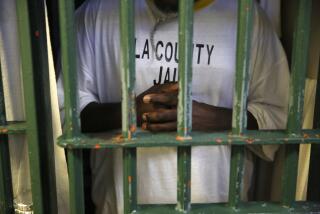Asking for Trouble in Our Prisons
- Share via
Last November, a San Francisco jury awarded the family of convicted murderer Mark Adams more than $2.3 million in damages. Adams was shot and killed at San Quentin State Prison in 1994 by a correctional officer trying to break up a fistfight that Adams had initiated with another inmate.
The payout to the Adams family was a fitting close to a year in which the Department of Corrections found itself the subject of an extended and intense hearing before the Legislature for its policy on the use of force at Corcoran State Prison.
The hearings brought to light the unsettling fact that since 1989, 39 inmates in California prisons have been shot and killed by correctional officers who were attempting to break up fights or quell disturbances. During this same period in the remaining 49 states combined, a total of two inmates died under the same circumstances.
While the facts of each shooting deserve to be examined individually, such disparate numbers cry out for further examination. As troubling as the number of shootings were, the conclusions last fall by a blue-ribbon panel of retired police officers that five fatal shootings and 19 incidents in which Corcoran inmates were wounded were not justified. Atty. Gen. Bill Lockyer has used the findings of this panel as a springboard to open an official inquiry into two dozen serious and fatal shootings of inmates by Corcoran guards between 1989 and 1995.
After listening to dozens of hours of witness testimony during legislative hearings, I have concluded that the adequacy of prison guard training deserves immediate attention.
According to the Commission on Peace Officers Standards and Training, the minimum number of hours acceptable for a law enforcement agency’s training is 664 hours, or a little more than 16 weeks. The average length of training for all law enforcement agencies in California is 850 hours, or 21 weeks. Currently, the training for correctional officers is six weeks--a grand total of 240 hours.
Think about it this way: Correctional officers receive about one-third the training given by every law enforcement agency in California. Consider that during this era of prison overcrowding, only the most dangerous and violent of all convicted felons will actually do any time in prison. Thus we have a situation where correctional officers, with only a fraction of the training given peace officers who spend a good deal of their time dealing with the general public and far less dangerous criminals, must spend every single minute of their working day maintaining control over the most violent and dangerous members of the California felon club. This disparity defies logic and cries out for reform.
Because of the limited training time for correctional officers, many valuable and some necessary subjects are left out of the curriculum. Trainees receive only the most cursory instruction in criminal law and procedure, for instance. Search and seizure law, highly relevant for guards who must maintain order and safety in prisons and yet protect the constitutional rights of inmates, gets just one hour in the curriculum.
Apart from the wholly inadequate classroom curriculum, correctional recruits get relatively little time in weapons training. While the California Highway Patrol and other police agencies such as the Sacramento Police Department have their trainees fire no fewer than 2,500 rounds, corrections recruits fire only about 300 rounds--one-eighth the number fired by the average law enforcement agency training. In fact, the 37-millimeter gas gun, the first line of firepower used by correctional officers for quelling inmate disturbances, is never fired by recruits during training.
Given this wholly inadequate training for prison guards, it comes as no surprise that Californians have witnessed such an unacceptable level of death and mayhem within our prison walls over the last decade. Nor should it surprise any taxpayer that the Department of Corrections has paid out more than $22.4 million to inmates and their families in legal awards and settlements since 1996.
Can we really expect to lure recruits with the promise of a fat paycheck, give them a crash course in how to manage the most dangerous felons in the world, leave out all applicable case law, periodically have them fire a gun and then expect them to perform at an acceptable level? The state’s sorry statistics give us the answer.
Rarely in my legislative career have I seen such a critical problem with such an obvious solution. I call upon the Legislature and Gov. Gray Davis to live up to our duty to ensure the safety of all our citizens--prisoners included--by mandating that correctional officers receive training commensurate with their responsibilities.


